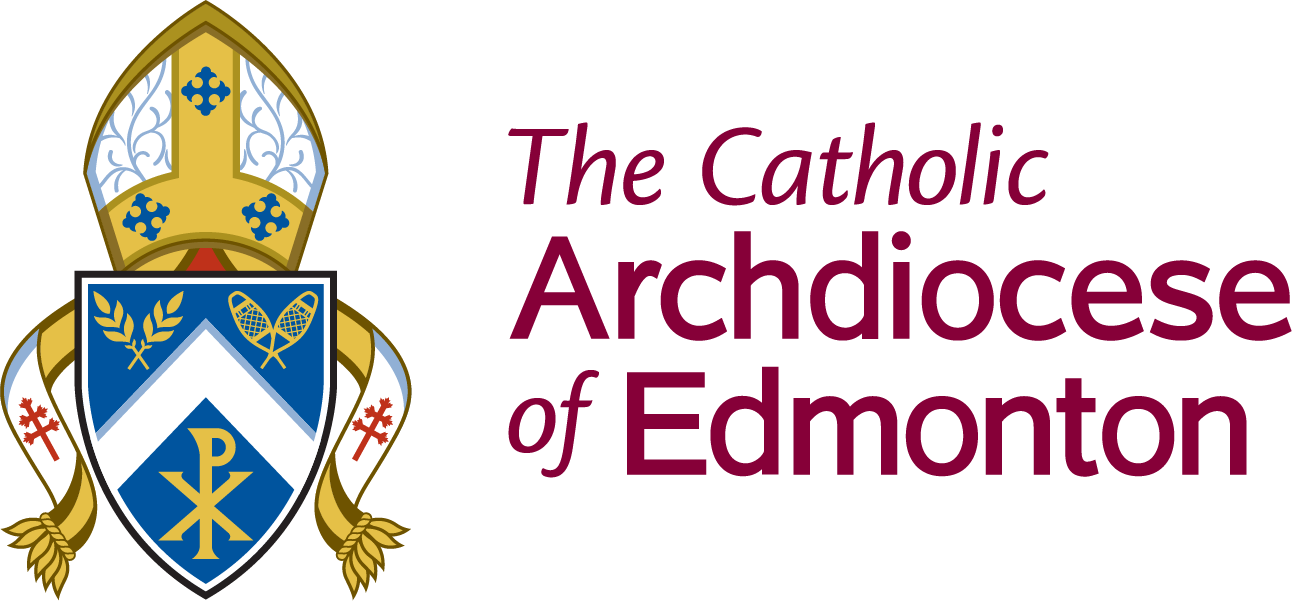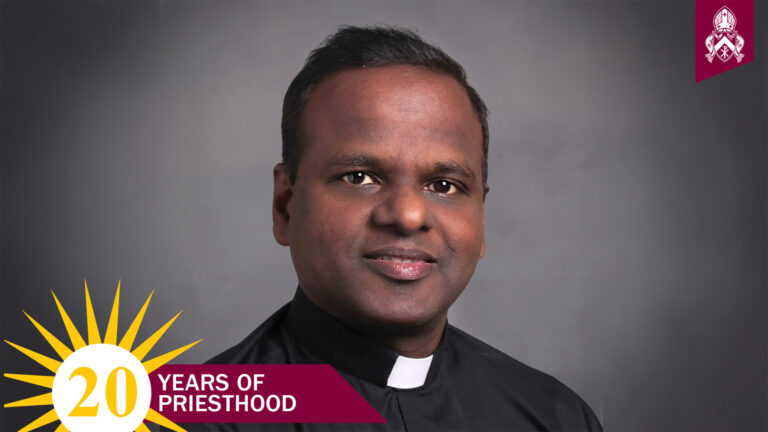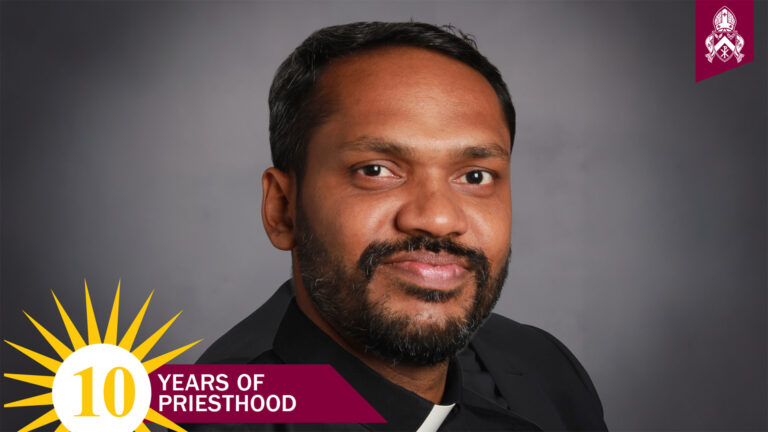Archbishop’s Dinner 2023
Speaking Notes of Archbishop Smith
Introductory Remarks
Thanks to Joan and Fr. Jim for their introduction. Just recently I learned a new way to introduce myself. A couple of weeks ago, I visited an elementary school, K-6. I had with me the case in which I carry many of the items I use when celebrating the mass, and the children agreed I should do a bit of “show and tell” with them. Now, they had been prepared for the visit by their teachers, so before I had time even to open the case, one little voice hollered out: “Show us the sheep thing!” The sheep thing? After a second, it dawned on me that he was referring to the Bishop’s pastoral staff. So, hello, I’m the guy that does “the sheep thing” and I am delighted to be with you.
A heartfelt welcome to everyone! I am thrilled that you have all accepted the invitation to gather once again for what we like to call a grateful gathering of the Catholic community in central Alberta. There is much for which we are grateful – God has blessed us abundantly here in the Archdiocese, and it is simply good to be together and celebrate that.
The last time we did this was four years ago – in 2019. At that inaugural dinner, we announced our intention to hold this event annually. Well, we know what is said of “the best-laid plans”. That particular plan certainly did go awry, as did countless others globally due to the pandemic. That was a difficult time, to say the least, but developing and managing an appropriate response to COVID was not the only challenge we faced. In addition, here locally we were also called to embark upon a renewed journey of healing and hope with the Indigenous Peoples of this land, and the global spotlight, often rather intense, was focused directly upon us. This culminated in the visit of Pope Francis to Canada, for which we had the particular blessing and honour of working with local Indigenous communities to be the first to welcome the Holy Father to this land and set the stage for an extraordinary encounter, pivotal in the history of Canada.
Recalling all of this fills my heart once again with immense gratitude to you all. When I think back to the priests and parish staff who guided our people in the difficult and fearful circumstance of an unknown and dangerous disease, those parishioners who registered people for mass during COVID, counted heads, marked off seating areas, set down direction arrows, sanitized our pews, enabled livestreaming, dealt graciously with people who were upset, anxious, uncertain, or afraid – the list goes on; when I ponder our trustees, teachers, professors, healthcare professionals, administrators, and social workers in our Catholic institutions carrying on their ministries with great fidelity under enormous pressure; when I consider the countless volunteers, together with many wonderful collaborators at all levels of government, who worked night and day, under very intense circumstances, to prepare for a papal visit in a frighteningly short space of time – and pulled it off (!); when all of this passes through my mind, I can tell you that I feel not only enormous gratitude to each and every person but also very proud of you all and thankful to God for the blessing to serve as Archbishop of what is obviously an incredibly dynamic community of faith. We have been through a lot, but the way in which you have all risen to these immense challenges fills me with great confidence and excitement as together we face both the present and future as a people fully dedicated to the mission of the Gospel.
The Mission Before Us
And that’s exactly what I’d like to speak about this evening. The perennial question faced by the People of God throughout the history of the Church is how to announce the Gospel of Jesus Christ to the times in which they are living. The challenge we face in our day, the task impressed upon us by current circumstance, is this: how shall we point out to our contemporaries that there is reason to hope? That is no small task, and it is an urgent one. You don’t need me to tell you that the absence of hope is arguably the defining characteristic of our time. Anxiety abounds. It will be some considerable while yet before our world emerges from the deep trauma occasioned by the pandemic. In addition, geopolitical instability, dramatic and at times lethal environmental changes, the widespread questioning of what it means to be a human being, the enormous economic pressures weighing upon a growing number of individuals and households, and the wide, often angry polarity separating peoples all combine to undermine the certainties and predictabilities on which we have heretofore relied as the foundation of confidence and security. I am hearing people speak increasingly of their deeply felt sense of hopelessness as regards both their present circumstances and future outlook. Where do I look for hope – hope that has a rational basis and is not simply a willed optimism?
Our task is, precisely, to answer that question. I am convinced that the call of the Lord to his Church right now – to you and me – is to make clear to the people of our day that there is reason to hope and show them where to find it. Tonight, I would like to propose to you how we can do just that, and invite you to join together with me in engaging this mission.
Allow me to share with you my read of the situation and then my proposal for moving forward. With respect to an analysis of what lies at the heart of all we are experiencing right now, I take for my inspiration Saint Kateri Tekakwitha. Regarding our response as disciples of the Lord, I believe we can do no better than follow the direction given by a kindergarten class.
The Example of Saint Kateri
Let’s begin, then, with St. Kateri. Her statue, which you see on the screen behind me, stands on the grounds of our pastoral centre, seminary, and theological college. Whenever I drive by it, I like to offer a brief prayer to her. We also have highlighted here in this room a small statue of the saint blessed by Pope Francis when he visited Sacred Heart Church of the First Peoples. Born in 1656 of Algonquin and Mohawk descent, she is the first Indigenous person from what is now Canada and the United States to be recognized as a saint. The Christian faith she received from her mother took deep root within her, and blossomed in spite of severe persecution that she experienced at times. She dedicated her life entirely to Christ, choosing therefore not to marry. She was baptized into the Catholic Church at the age of twenty and died a mere four years later. When she was canonized by Pope Benedict XVI in 2012, he described her as protectress of Canada. So, she is for all of us. Along my journey with Indigenous Peoples, I have learned many beautiful lessons from the wisdom implicit in their traditions and cultures. In the person and life of this one particular Indigenous woman, Saint Kateri, we have an example that the Church holds out for all of us to emulate as we embrace the call of this moment.
The one aspect of her life that is especially relevant for us in our present circumstances pertains to her vision. Kateri was the sole survivor in her family of a smallpox epidemic that ravaged the area when she was only four years of age. It left her face deeply scarred and her ability to see severely impaired. The name assigned to her by her adopted family – Tekakwitha – derived from her diminished capacity for sight. I am given to understand it means \”she who feels her way ahead\”, or \”one who bumps into things”. In other words, the term has to do in one way or another with seeing what lies before. Here is the point: although Kateri\’s physical sight was seriously compromised, nevertheless her inner vision was clear. Deep within her heart she had received the gift of seeing clearly the truth of Jesus Christ and his Church. It is as if God, through the very name “Tekakwitha” and the life of the one who bore it, was drawing attention to the limits of human vision in order to point us to the true sight that comes from faith. The gift of faith carries with it the capacity to see clearly the love of God and His abiding presence, working in and through all the events of our lives to both care for and carry us toward the fulfillment of the destiny he has given to the world in his Son Jesus. This is the sight that engenders hope.
From Kateri’s example we can appreciate what lies at the root of so much of the hopelessness felt today: it is the inability to “see”. Sadly lacking is the inner spiritual sight that can see through and beyond the immediately sensible to the greater transcendent reality of the presence and providence of God. In consequence, we have become a people who “bump into things” as we “feel our way forward” in a world that has seemingly grown very dark. When we cannot see the path ahead, frustration, fear, and anger ensue. These are causing us to walk into and over one another, and human society has fractured. Our call, then, is clear. We are to help the people of our day recover their sight, to lead them to the clarity of vision that sees and rejoices in the love of God, in whose presence and action we find real and abiding hope.
How shall we do this? In answer, I offer you a lesson learned in kindergarten.
The Lesson from Kindergarten
A few years ago, I was visiting some schools in Red Deer. In one of them I was taken to meet the children of the kindergarten class. There they asked if I would read to the kids a book written to tell the Easter story. How could I say no to something like that? The children were precious, with their smiling, eager, and cherubic faces. So, I agreed.
They gave me a chair and all the children sat on the floor around me. I read the story aloud to them, and they listened with rapt attention. So cute. As I neared the half-way point of the book, one of the children hollered out, “Hey! Aren’t you gonna show us the pictures??!!” Oops. I forgot I was supposed to do that. Other voices picked up the theme, and I began to hear mumbles of “Yeah! Show us the pictures.” The smiles were swiftly turning to scowls. I immediately began to show them the pictures as I continued with the story, but that was not good enough for one very indignant little girl. “Start over!” she commanded, and all the others quickly rallied to her cry. “Yeah! Go back and start again!” It was a mutiny! I can still remember thinking to myself, “How in the name of heaven did I manage to mess this up?!” The principal and teachers were stuffing their fists down their throats to stifle the guffaws. I can well imagine that copious salt was poured into my wound of embarrassment when the kids later told Mom and Dad the Archbishop doesn’t even know how to tell the Easter story.
Tell the story; show the pictures. That’s the lesson for us all from my friends in that kindergarten class. The way we give to our contemporaries the clear vision that gives birth to hope is both to tell the story of Jesus Christ risen from the dead and demonstrate its truth by the pictures we form with our lives. Tell the story; show the pictures.
Tell the Story
If we are to tell the story, we need to be well versed in it. At your place, you will have seen by now a pocket edition of the Gospels and Psalms. Please accept this as my gift to you. Here I am taking a page from Pope Francis, who has been known to give out to the crowds gathered for his Sunday Angelus a book of the Gospels to be kept with them at all times. The encouragement implicit in the gift is, of course, to read the Sacred Scriptures. To tell the story we have to know it, and knowing it comes from regular and repeated reading. Tonight, I invite us all to a renewed commitment to read prayerfully and regularly the Word of God, so that we become increasingly expert in telling the Easter story.
This is the story that alone can ground real hope. If Jesus has risen from the dead, we know that there is no situation, however difficult or desperate, from which he cannot rescue us. Nothing is beyond the power and reach of the Risen Lord. Yet we know there are a multiplicity of stories in circulation drowning out the one we are charged to tell. This is why many of you will have heard me pose on numerous occasions the question that I feel is most urgent in our day: “Who are you listening to?” I ask it repeatedly because it takes us directly to what lies at the heart of the polarity from which we are suffering. Modern means of social communication have become a deluge of disparate voices – often angry – with multiple messaging. Those to which we give our attention shape our mindset and hence our behaviour, resulting in separation and distance, marked increasingly by words and attitudes that are anything but civil and drain our hearts of the hope for which we long. One story alone can restore us to unity with one another and re-ignite hope, namely, that of Jesus Christ, risen from the dead. So, let’s read the Gospels, ponder them, savour them, and, as St. Paul says, let the Word of Christ dwell richly within our hearts (cf. Colossians 3:16). This will enable us to tell the story and give an account of the hope that is ours as followers of the Lord (cf. 1Peter 3:15).
Show the Pictures
As we do, let’s remember the kindergarten lesson that we also need to show the pictures. Tonight, I will briefly speak about three such “pictures” by which the Christian community has traditionally communicated the Gospel of hope. These are: worship, witness, and service. I’ll briefly consider each in turn and then bring these reflections to a close.
Worship
Whenever we gather for the worship of Almighty God, we form the picture of a people assembled around the source of hope, Jesus Christ. The wonder that unfolds in the mass before the eyes of faith to awaken hope is portrayed beautifully, in my estimation, in the mosaic above the tabernacle at St. Joseph’s Basilica, which you can see on the screen behind me. Its image is based upon the vision of heavenly worship now received by Jesus, the Lamb of God, reigning in heaven. The representation radiates a summons to hope, and here is why: it reminds us that when we celebrate the mass, heaven is united to earth. The same Jesus now reigning in heaven as King of Kings and Lord of Lords renders himself present in our humble earthly liturgy. This means that the mass is the presence of God’s heavenly kingdom within the many “kingdoms” of this world. God’s definitive victory over evil continues on the march with its transformative power, a wondrous mystery that cannot fail to fill us with the sure hope that all of the difficulties we encounter, present or to come, will never have the last word.
The mosaic also captures the call we receive in the Eucharist to bold and courageous mission: “Ite, missa est”; Go, you are sent!” Notice that the Lamb who was slain upon the Cross is alive and standing. The blood pouring from his wounded side into the chalice tells us that, in the Eucharist, we are given a share in his victorious life, which enables us also to stand. I draw attention to this because we have all been weighed down in the last while with the various pressures that have come upon us. Jesus is inviting us to draw new strength from him to stand up and stand firm in the strength of the hope that he is. Having been on the back foot for some time, now is the moment to both stand firm and step forth. By embracing this call, our act of worship forms the picture of people on a mission of hope, moving with the strength that comes from communion with our risen Lord.
Witness
This brings me to the second picture: witness. How shall we step forth to give witness to hope before the people of our day? When Pope Francis visited us, he came as a pilgrim to walk with us along the pathway of penitence and reconciliation. The theme of the papal visit was “walking together”, to which the Pope is calling the entire Church through the synodal process. In a message directed not only to those gathered with him at Sacred Heart Church of the First Peoples but also to Catholics everywhere, the Holy Father looked to the Cross of Christ and then spoke of the Mystical Body of Christ, his Church, as “the living body of reconciliation”. Implicit here is the invitation to all of us, right now, to fix our gaze on the Cross and embark on our own pilgrimage of penitence and reconciliation. Resentments and bitterness still linger from the pandemic. Hurts from the past are passed on through generations. The clear vision of faith sees Jesus on the Cross breaking down the dividing walls of hostility that keep people apart (cf. Ephesians 2:14). Standing firm and stepping forth means actively seeking to be reconciled and thus become what we are: a living body of reconciliation. So, let’s have the courage and humility to ask ourselves where we need to seek forgiveness or grant it. Our world cannot afford to remain mired in antipathies. It will, though, as long as it lacks the vision to see the way forward. We are called to provide that vision by standing up in the midst of our world as a sign that reconciliation can be a reality in our day, and thus a picture of hope.
Service
Finally, the picture of service. It has long been obvious to me that serving others is in the DNA of the people of this Archdiocese. The portrait we fashion by our good works is a large one, since the impact we make on our province through service is immense. As evidence of this, we need think only of the educational ministry to the more than 90,000 students in our Catholic schools and colleges; the healing services offered across the province to people along the full spectrum of life by over 11,000 employees and 900 volunteers of the Covenant Heath family; the care given to 20,000 vulnerable persons annually by the 1800 employees and 400 volunteers of Catholic Social Services; the concrete assistance offered annually to 11,000 poor and needy individuals by 600 volunteers in 20 conferences of the Saint Vincent de Paul Society; and the pastoral care and manifold outreach programmes to countless individuals extended by priests, deacons, consecrated persons, and lay faithful in our 124 parishes and missions. Tonight, I would like to emphasize that what unites these various forms of service is the shared conviction that each and every human being, at every stage of life and in any circumstance, is possessed of an inalienable dignity that must at all times be respected and honoured. Collectively, we can offer no greater act of service to our country at this moment than to stand strongly for the dignity and sanctity of every human life, and boldly against anything that threatens it. Many threats there are, including now the unconscionable legalization and provision of euthanasia, all stemming from an illusory sense of autonomy and false understanding of freedom, and ultimately symptomatic of a tragic loss of hope. The clear inner vision of faith recognizes God as the Author of all life and ourselves as its stewards. The death and resurrection of Jesus marks every human life without exception as beautiful and necessary, deserving of protection, and worthy of celebration. Our unity as a people in the service and defence of life is perhaps the most eloquent picture by which the truth of the Easter story is told, and real hope communicated.
Conclusion
By way of conclusion, allow me to return to Saint Kateri. Among the most striking aspects of her witness is the miraculous transformation of her face soon after her death. From the age of four terribly scarred by smallpox, her face was restored to its original beauty only minutes after she had died. This was preceded by the words she spoke just as her life ended: \”Jesus, I love you.\” The love of Christ for us, and our answering love for him, heals. We may not bear physical scars, but so many people today carry deep and debilitating emotional and psychological ones. These are inflicted not by smallpox but by poverty, addiction, loneliness, disappointment, and betrayal. So much pain, so many emotional scars! Yet Kateri teaches us that no wound, however deep, should leave us without hope. When inner vision sees the love of Christ for each of us, and perceives his mercy active in our world, real hope arises in the heart. Our call is to announce this victorious love by both telling the story in word and demonstrating its transformative power in the pictures we form by worship, witness and service.
I have been enormously blessed to serve as your Archbishop for sixteen years now. If the Lord grants it, we shall be together for another eleven. Let’s use this time to move forward, joyfully and boldly, as a united people of mission, grateful that God has chosen us at this moment in history to be agents of the hope He has given in Jesus, His Son and our Lord.
Thank you and God bless!
Most Reverend Richard W. Smith
Archbishop of Edmonton
October 6th



